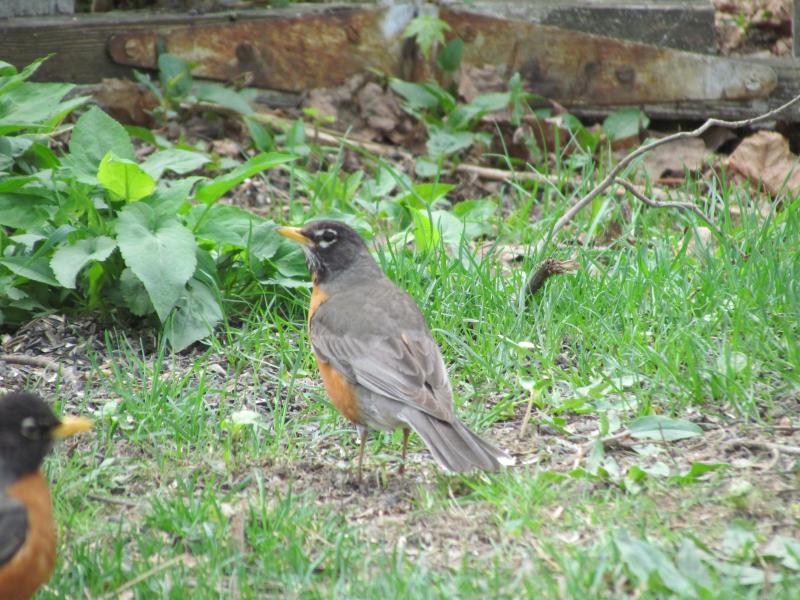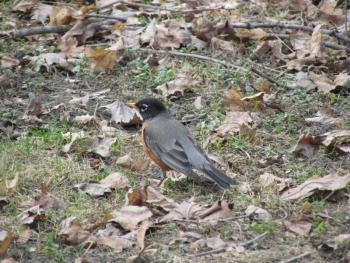On this morning’s walk around the neighborhood with our little dog, Loki, it was as if spring had soared in overnight. From every single yard, we heard the “pip-pip-pip” calls or the sweet “cheerio-cheereee” songs of American robins. The lawns were just starting to get some green among the brown matted grass leftover from winter, but the robins didn’t care. They were standing here and there and everywhere, their reddish breasts puffed out as if they felt proud to be declaring their residency.
Robins are certainly birds that are abundant nesting inhabitants throughout most of the suburbanized parts of the U.S. and southern Canada. They are well-known and well-loved even by people who don’t know many other birds. What other bird hops around on lawns in plain sight, and sings loudly from the tops of garages and telephone poles, and nests in the expensive shrubbery we use to landscape around our homes? Maybe other birds, but not like the robins do.
What is shocking to many people, though, is that American robins also nest across vast landscapes of natural habitat, including across the northern Boreal Forest region of Canada and Alaska where suburbia and lawns are replaced by millions of acres of forests and peatlands. Their beautiful songs, echoing out across remote valleys and lakeshores, are a distinctive feature of the soundscapes of such wild places, just as they are for suburban neighborhoods farther south.
The name of our familiar American robin came from the early European settlers who, after a difficult voyage of months on the sea, arrived here probably looking for connections to where they had come from. A very familiar and comforting bird from England (and across Europe) was the red-breasted bird of gardens and yards that they knew as the robin. Today we refer to that species as the European robin in order to differentiate it not only from the American robin, but from the many other birds around the world that now also bear the name robin.
The British, in particular, seemed to often want to remember the birds back home wherever they ended up in the world. There are now unrelated birds called robins or that have “robin” as part of the name (like the robin-chat or magpie-robin) in Australia, New Zealand, Africa, and Asia.
Long before the first Europeans came to the shores of North America and started calling our bird “robin,” the species had many names in the Indigenous languages of the peoples that had been here for millennia. Some of the names are (or are thought to be) based on sounds the birds make. Some imitate the songs; others the calls. Still other Indigenous names describe something about the bird. Some called the bird a name meaning “the whistle maker” or “one who whistles.” And another as “the bird that is good at digging.”
One name we really like is what one source described as the Mi'kmaq (sometimes spelled in other ways) word, “nikchipkudaagedoo,” which was said to mean “leaf rattler.” What a great way to describe the way the birds we know as robins dig around in the leaves as they search for food!
Jeffrey V. Wells, Ph.D., is a Fellow of the Cornell Lab of Ornithology and Vice President of Boreal Conservation for National Audubon. Dr. Wells is one of the nation's leading bird experts and conservation biologists. He is a coauthor of the seminal “Birds of Maine” book and author of the “Birder’s Conservation Handbook.” His grandfather, the late John Chase, was a columnist for the Boothbay Register for many years. Allison Childs Wells, formerly of the Cornell Lab of Ornithology, is a senior director at the Natural Resources Council of Maine, a nonprofit membership organization working statewide to protect the nature of Maine. Both are widely published natural history writers and are the authors of the popular books, “Maine’s Favorite Birds” (Tilbury House) and “Birds of Aruba, Bonaire, and Curaçao: A Site and Field Guide,” (Cornell University Press).


























